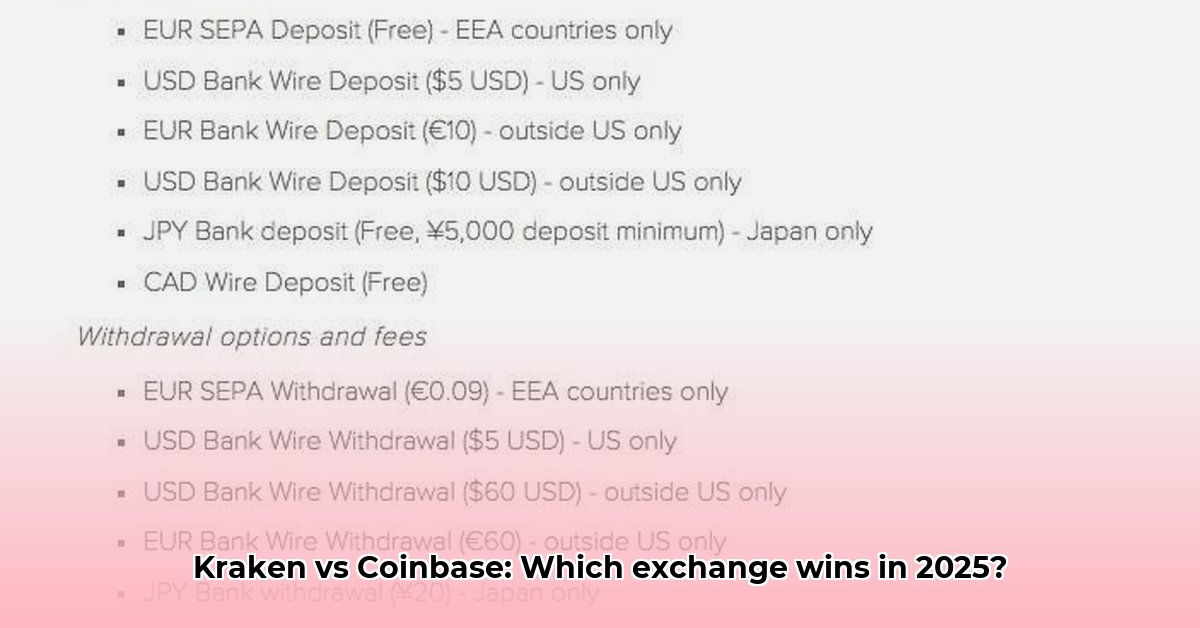
Choosing the right cryptocurrency exchange is crucial for maximizing profits and minimizing risks. This comprehensive guide compares Kraken and Coinbase, two leading platforms, focusing on their fee structures, features, and suitability for different user types. We'll empower you to select the exchange that best aligns with your trading style and investment goals in 2025.
Diving Deep into Fee Structures: A Comparative Analysis
Both Kraken and Coinbase charge fees, but their structures and implications differ significantly. Understanding these nuances is critical for making an informed decision. Kraken utilizes a maker/taker fee system (where makers, adding liquidity to the exchange, often receive rebates, while takers, removing liquidity, pay standard fees), incentivizing high-volume trading with potentially lower costs. Coinbase generally employs a simpler, flat-fee structure, which may be easier to understand but might prove more expensive for frequent traders.
Here's a detailed comparison:
| Feature | Kraken | Coinbase |
|---|---|---|
| Fee Structure | Maker/taker (volume-dependent; rebates possible for makers) | Flat fees (vary by cryptocurrency and payment method) |
| Withdrawal Fees | Variable, depending on the cryptocurrency and withdrawal network. | Variable, depending on the cryptocurrency and withdrawal network. |
| Deposit Fees | Generally low or waived. | Generally low or waived. |
| Transaction Speeds | Generally faster. | Generally suitable for most users. |
| Ease of Use | Steeper learning curve; more complex interface. | User-friendly interface; better suited for beginners. |
| Typical Fee Range | Can range from essentially free (for makers with high volume) to standard taker fees. | Generally higher than Kraken's lowest fees, but simpler to understand. |
Isn't it frustrating trying to decipher these complex fee structures? Let's clarify: While Kraken's maker/taker model offers the potential for significant cost savings for high-volume traders, Coinbase's straightforward, albeit potentially higher, flat-fee structure simplifies the process for those prioritizing ease of understanding over potential cost optimization.
Beyond Fees: A Holistic Comparison of Key Features
While fees are crucial, a comprehensive comparison must consider other factors impacting user experience and investment outcomes.
Cryptocurrency Selection
Kraken generally boasts a broader range of supported cryptocurrencies, including many less common or newly launched assets. Coinbase focuses on a more curated selection of established cryptocurrencies. Which platform's selection is more suitable depends entirely on your investment strategy and preferences. What cryptocurrencies are most important to your investment portfolio?
User Experience (UX)
Coinbase generally receives higher marks for user-friendliness. Its intuitive interface makes it ideal for beginners. Kraken, while offering advanced features appealing to experienced traders, presents a steeper learning curve.
Security
Both exchanges employ robust security measures, including two-factor authentication. However, the inherent risks associated with cryptocurrency trading should always be acknowledged. Regularly review both platforms' security announcements and practices to stay informed about the latest upgrades and potential threats.
Regulatory Compliance
Both platforms operate within existing regulatory frameworks, although the specifics vary with jurisdiction. Maintaining awareness of regulatory developments in your region is crucial.
Customer Support
The quality and responsiveness of customer support vary between platforms. It's essential to research the reputation of each exchange's support channels before making your decision.
Actionable Recommendations: Choosing the Right Exchange for You
The optimal exchange depends on several factors:
- Trading Volume: High-volume traders might benefit from Kraken's potential for fee rebates, while casual investors might find Coinbase's flat fees more manageable.
- Technical Proficiency: Beginners will likely find Coinbase’s user interface more intuitive, while experienced traders might appreciate Kraken's advanced features.
- Cryptocurrency Preferences: Kraken's wider selection appeals to those interested in less mainstream cryptocurrencies, while Coinbase's curated options suit investors focused on established assets.
- Risk Tolerance: Thoroughly research the security practices of each exchange and understand the inherent risks associated with all cryptocurrency trading.
Recommendations:
- High-Volume Traders: Kraken's maker/taker system, with its potential for reduced fees, is generally advantageous.
- Beginner Investors: Coinbase's simplicity and user-friendly interface are optimal starting points.
- Institutional Investors: A thorough comparison of each platform's institutional services and fee schedules is essential.
Conclusion: Your Journey to Choosing the Best Crypto Exchange
No single "best" cryptocurrency exchange exists. The ideal platform depends on your trading style, experience level, and investment objectives. By carefully considering the fee structures, features, and security measures of both Kraken and Coinbase, you can make an informed decision that aligns perfectly with your needs. Remember, thorough research and understanding your own risk tolerance are essential for successful cryptocurrency investing.